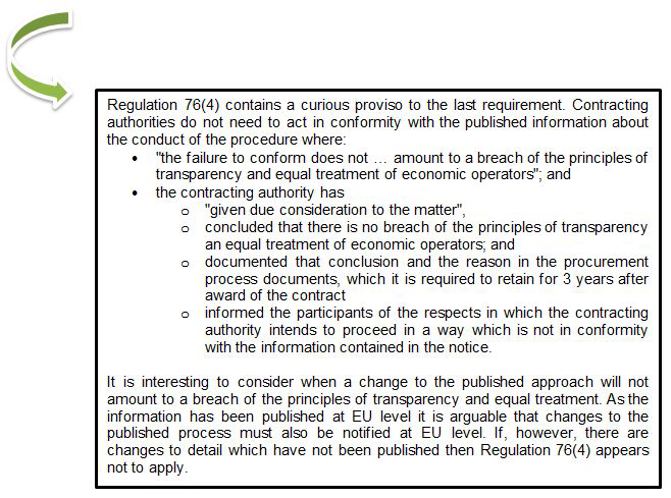20/10/2014

This procurement byte looks at the provisions in the Directive (2014/24/EU) and the Public Contracts Regulations 2015 covering the new “light regime” for social, health and other specified services.
Background and general overview
Under the 2004 Directive and 2006 Regulations, services were classified as either “Part A” services, which were fully regulated, or “Part B” services, which were only regulated lightly. The new Directive/Regulations abolish this concept. All services are subject to full regulation unless they fall within the list of services which are subject to a new “light touch regime”.
The new light touch regime requires contracting authorities to advertise contracts for light regime services, worth €750,000/£625,050 or more, in the OJEU. The way in which the procurement process is run is not regulated in detail in the Regulations. Member states are required to implement their own rules on procurement processes for light regime contracts, subject to complying with transparency and equal treatment principles and some other limited provisions explained below.
What are light touch regime services?
Light touch regime services are listed in Schedule 3 of the Regulations. In practice the list of services covered by the “light touch regime” looks very similar to the list of Part B services. There are, however, some services which were Part B services but which are now fully regulated and so you have to check the list very carefully.
What is the threshold?
As mentioned earlier, the threshold is €750,000 (£625,050). The value of the contract must be calculated in accordance with the general rules applying to all public contracts which are set out in Article 5/Regulation 6. The equivalent value in £ is fixed until 31 December 2015 and will then be revised along with the other financial thresholds.
Where and how do we advertise?
Light touch regime contracts at or over the threshold must be advertised in the Official Journal of the European Union (OJEU), using standard form notices. All contracting authorities may use either a Contract Notice to advertise in the OJEU or an enhanced Prior Information Notice, which can be published a year or more in advance and which can cover multiple contracts. (see Byte size procurement update 2 for more information on using a PIN as a call for competition).
The standard form notices must contain the information listed in the Directive at Annex V Part H (contract notice) or Part I (PIN as a call for competition).
Part 4 provisions also apply and so contracting authorities also need to comply with the obligations to publish information on Contracts Finder.
What procedures do we use to award a light touch regime contract?
The Directives do not specify what procedures apply as this is left to individual member states to decide.
The Regulations do not oblige contracting authorities to use one of the standard procedures for award of contracts, such as the open or restricted procedure, although contracting authorities are free to use and adapt those procedures if they wish (Regulation 76(7)).
Procedures devised by the contracting authority
Contracting authorities may use other procedures which they devise themselves, subject to a limited number of requirements which are set out in Regulation 76(3) and (5). These are:
- The procedure must comply with the principles of transparency and equal treatment of economic operators
- All time limits imposed on economic operators must be reasonable and proportionate
- The contracting authority must conduct the procedure in conformity with the information it set out in the advertisement concerning the conditions for participation, time limits for economic operators to contact the contracting authority, and the main features of the award procedure to be used.

Factors which contracting authorities may take into account: Regulation 76(7) transposes provisions from the new Directive which permit, but do not require, contracting authorities to take into account a list of factors such as the need to ensure quality, continuity and accessibility, the specific needs of different categories of user, user involvement and empowerment and innovation. These provisions acknowledge the nature of many of the light regime services which have a direct impact on service users who may have particular needs.
Award of light touch regime contracts
Standstill (Regulations 86 & 87)
The standstill provisions do not apply where the contract is permitted to be awarded without prior publication of a contract notice (Regulation 86(5)). As Regulation 75(1)(b) permits light regime contracts to be awarded without prior publication of a contract notice, technically the standstill provisions do not apply. However, CCS Guidance states that it is advisable nevertheless to run a standstill and doing so can help minimise subsequent challenges. It also demonstrates compliance with the transparency principle.
Contract award notice
Contracting authorities must publish a contract award notice in the OJEU using a standard form containing the information set out in the Directive at Annex V Part J. Article 50/Regulation 50 appears to apply and so the contract award notice should be sent for publication no later than 30 days after conclusion of the contract. Under Article 75(2)/Regulation 75(4) contracting authorities have the option to group together notices and publish them quarterly within 30 days of the end of each quarter.
Remedies
The usual remedies are available, including the ability to obtain an automatic suspension where a claim is issued in relation to a decision to award a contract, and damages. The remedy of ineffectiveness is not available in relation to contracts for services covered by the light touch regime unless rules on frameworks are breached.
Comment
The comment above on the availability of the remedy of ineffectiveness is based on there being no requirement to publish a "contract notice" for light touch regime services (as it is the failure to publish a contract notice in circumstances which required publication which triggers Ground 1 of ineffectiveness). If however, the new obligation to publish a "call for competition" by means of an enhanced PIN fell within the definition of a "contract notice" this could open up the remedy of ineffectiveness to light regime awards. If a contract notice is not required because an enhanced PIN is a permitted alternative then, arguably, Ground 1 will not apply where the PIN route is used. For the light regime contracts, if standstill provisions do not apply, then this will not trigger the second ground of ineffectiveness.
Delay in application of the light touch regime to the commissioning of health services for the purposes of the NHS – 18 April 2016: Regulation 118 provides that the light touch regime will only apply to the procurement (“commissioning”) of health services for the purposes of the NHS from 18 April 2016. The current Part B regime and NHS Procurement, Patient Choice and Competition Regulations 2013 will continue to apply to the commissioning of those services until that date.



